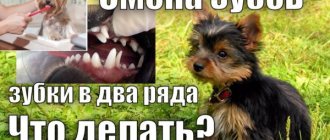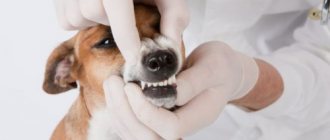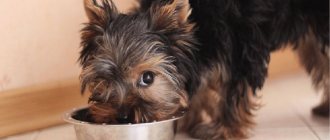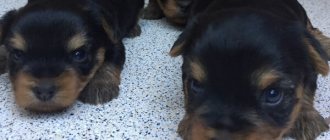Healthy teeth and correct bite in a Yorkie are not only a sign of good health of the dog, but also a source of pride for its owner. Unfortunately, not all Yorkies can boast of even, snow-white fangs. If your pet is not looked after too carefully, its teeth become covered with plaque, which over time hardens and turns into tartar.
And problems during the change of teeth in puppies of this breed are not uncommon. Therefore, in order for the dog to develop a correct bite, you need to carefully monitor how the teeth change so as not to miss possible deviations.
What are they?
The dog's dental system consists of incisors, canines, false roots and molars, as well as premolars and molars. The first premolars are deciduous and are replaced by permanent ones at the age of 4-5 months. But molars are only permanent and are absent in puppies.
In total, adult dogs have the following set of teeth:
- Twelve incisors (6 each on the upper and lower jaws).
- Four fangs (2 on each jaw).
- Sixteen premolars (8 each above and below).
- Ten molars (4 on the upper and 6 on the lower).
The first of the premolars, located immediately behind the canine, is usually very small in size; it also happens that in place of one of these teeth, a dog grows two.
Features of the structure of the Yorkie's jaw
By the end of the development of the skull, the Yorkie should have 42 teeth: 20 in the upper jaw, 22 in the lower. Yorkie teeth classification:
- incisors;
- fangs;
- premolars;
- molars.
If a dog is missing at least 1 tooth, you can forget about a show career. A professional judge cannot give preference to a dog with an incomplete set.
Possible problems
The presence of all teeth and their good condition is very important for a Yorkie. In particular, the normal functioning of the digestive organs depends on the condition of his dentition. On the other hand, the health of your pet’s teeth depends not least on the quality of its diet. So, if you feed your Yorkie correctly and fully, then the change of teeth occurs in a timely manner and, as a rule, passes without complications.
But sometimes problems arise due to improper growth of teeth. Most often, such pathologies are hereditary in nature and are especially typical for small varieties of Yorkies: mini and micro. It is poor heredity that most often explains such a common problem among Yorkies as delayed tooth change.
In this case, the baby teeth have not yet had time to fall out, but the permanent ones are already cutting. As a result, not finding an exit to the surface, the permanent teeth begin to grow sideways or, in severe cases, form a second row of teeth next to the first, consisting of baby teeth.
If the puppy has a delay in changing teeth, then this problem cannot be ignored: it is necessary to contact a veterinary clinic as soon as possible.
Due to improper replacement of teeth, a Yorkie's bite may deteriorate, which will make it impossible for him to have a show career. Or the dog will not be able to eat normally and will experience constant discomfort due to inflamed gums. Another common problem in Yorkshire Terriers is the rapid formation of tartar.
At first glance, it is not associated with changing teeth. But often, precisely because of the formation of double dentition, high-quality cleaning of a dog’s teeth at home becomes impossible. On the side that cannot be cleaned, plaque very quickly accumulates, which then turns into tartar.
Help with teething
When your puppy is teething, he will have an overwhelming urge to chew everything he can. He will practically not be able to control it. You should be understanding and patient and remember that this is a very temporary stage in relation to your Yorkie's entire life.
Your job will be to:
- Protect your home to prevent your Yorkie puppy from chewing on anything dangerous.
- Restraining the puppy if it gets out of control.
- Relieves teething to reduce itching and discomfort.
Change
Little Yorkies, like all other dogs, have no teeth when they are born. Their first teeth begin to erupt after 14 days. The canines are the first to cut: 2 of them grow on each jaw. Next, the premolars and incisors erupt, and this can happen either simultaneously or in turn. By 1.5 - 2 months, a Yorkshire puppy should already have 28 baby teeth. But if their number has grown less or, conversely, more than the required amount, then this is often a sign of future problems. The dog may develop an incorrect bite or not all of its molars will grow.
Around the third month of life, the puppy begins to change teeth. At this time, the molar tooth germ present from birth under each primary tooth begins to grow and, simultaneously with its growth, the root of the first tooth dissolves. Baby teeth gradually become loose and fall out, while permanent teeth grow through the canals formed at the site where the first teeth fell out.
When baby teeth grow, there should be no first premolar in the dentition. Its presence indicates that a permanent one will never be able to grow in that place.
Preventive health procedures
To maintain oral health, dogs need to have tartar removed. This is done using special pastes or in the veterinarian's office. Plaque on enamel can lead to inflammation of the gums and loss of incisors. Once every 2 weeks, small dogs need to put anti-gum gel into the oral cavity.
Important! Young dogs are not allowed to play tug games. Forceful loading on the jaw can deform it.
During the active change of the dentition, the dog should not be allowed to gnaw on very hard bones, metal objects and stones. They can deform soft, unformed gums.
It is necessary to periodically inspect the mouth of a young Yorkie. An even dentition and a standard number of teeth will help not only win prizes at exhibitions, but also maintain the health of the animal. Cleaning and removing stones will save your small pet’s chewing apparatus. You shouldn’t lead to possible problems.
Removal of milk
Incorrect positioning of teeth is not only a spoiled appearance. These include digestive problems, but also damage to the dog’s tongue and gums. To prevent this from happening, retained baby teeth must be removed in a timely manner. To do this, it is best to go to a veterinary clinic, where the doctor will easily and painlessly relieve your pet of this problem. This is a quick and uncomplicated procedure that is performed under local or general anesthesia. In order to eliminate the possibility of complications, it is recommended to examine the animal before the procedure and carry out the necessary tests.
Are Yorkies susceptible to disease?
Like other decorative dogs, Yorkies are susceptible to various diseases.
Special, attentive care for your pet can reduce the risk of diseases such as:
- joint diseases;
- gastrointestinal diseases;
- hypoglycemia;
- gum disease;
- hydrocephalus;
- allergy.
Bite
Normally, an adult Yorkshire Terrier should have 42 teeth: 20 on the upper jaw and 22 on the lower jaw. The bite, according to the breed standard, is only scissor bite. However, due to problems with improper tooth growth, an incorrect bite may form. But heredity or improper feeding of the Yorkie can also contribute to this.
Violations
Under the influence of various factors, a Yorkie's bite may begin to form incorrectly. The most common defects are partial teeth, when some of the teeth do not grow at all.
And the delay in changing teeth leads to the fact that sometimes, even after the removal of baby teeth, permanent teeth grow sideways.
This is why the dentition turns out to be uneven.
And sometimes it happens that the Yorkie exhibits a deviation from the standard scissor bite.
Both an undershot and an overshot may form. Normally, the incisors on the lower jaw of a dog should be adjacent to the internal planes of the upper ones, which slightly overlap them.
There are three types of malocclusion:
- Pincer-shaped: with it, the incisors on the upper and lower jaws touch their edges. This bite is also called straight.
- Undershot: with it, the lower jaw is shorter than the upper, causing the upper teeth to go ahead of the lower ones.
- Overshot: The lower jaw protrudes forward, causing a gap to form between the teeth.
It often happens that the bite deteriorates not for hereditary reasons, but because the owner does not pay attention to caring for his Yorkie’s teeth.
Visit to the veterinarian
The sooner your Yorkie starts visiting a canine orthodontist, the faster he will get used to dental procedures. The doctor will remove baby canines and incisors, install a device to straighten the teeth, correct the bite, and give recommendations for cleaning the pet’s mouth.
The dog is shown to the doctor even before the temporary teeth are replaced. The specialist will assess the condition of the animal’s jaw and give a forecast about the Yorkie’s future bite.
An adult is taken to the clinic 2 times a year to have tartar cleaned. Deposits are removed using a laser; the operation is painless.
Yorkshire Terrier at a doctor's appointment
Care
During the period of teeth change, the puppy needs special care and attention. At least 2 - 3 times a week you need to examine the mouth of a small Yorkie and, if it turns out that the growth of the molars is hampered due to the milk teeth that have not yet fallen out, it is necessary to take measures to remove them. When playing with a puppy, you should not pull anything from his mouth: this can easily ruin his bite. It is also undesirable to let your puppy chew on hard objects, as it can damage or even break the tooth.
In order for a Yorkie to develop its jaw muscles, it is necessary to give it not soaked dry food, but solid food with anatomically shaped granules that clean the surface of the tooth and at the same time contribute to the proper development of the dog’s jaws. At the same time, during the change of teeth, it is better to feed the puppy food with a high content of calcium and phosphorus.
If your pet eats natural food, then it is necessary to add vitamin and mineral supplements to its food. If this is not done, then problems may begin not only with the correct growth of teeth, but also with the exterior in general. For example, ears may fall off and paws may become crooked. It is very useful for growing puppies, and even adult Yorkies, to chew on special toys, as well as peeled raw carrots or an apple.
If plaque does form on the teeth, it can be cleaned off using a toothbrush with a special dog paste applied to it. Human pastes and tooth powders cannot be used for these purposes: they can cause allergies or stomach problems.
In order to reduce the risk of problems with teeth and bite, you should not take puppies whose estimated weight is less than 2 kg.
And if the owner is interested in the exhibition or breeding career of his pet, then it is better for him to buy a dog after changing teeth. If you take a small puppy, then you need to see what kind of bite his parents have.
Is it possible to replace brushing your Yorkie's mouth with treats?
Promotions of various dog treats will not leave anyone indifferent. They are said to completely clean the incisors and promote oral hygiene. This also applies to dry food. It is a mistake to believe that since dry food promotes jaw development, then the dog does not need anything else. This is only partly true, because no amount of treats or bones can replace brushing your teeth.
At least once every week or two, thoroughly clean your Yorkie's mouth. This will help avoid bad breath, tartar formation and yellow plaque. And for extra care, use vet-approved treats.
Temperature change
Fever is a warning sign that both people and dogs are feeling unwell. The normal temperature for Yorkies is 38.5-39 degrees.
NOTE!
On hot days and during heat, a Yorkie's temperature can rise by 3 degrees, and before giving birth it can drop by 0.5-2 degrees.
The cause of high temperature can be tick-borne piroplasmosis, viral enteritis, poisoning and postpartum eclampsia.
If your pet has a fever and chills, wet the ears and paw pads with cool water, place the pet in a cool room, and give him fresh water. You need to inject about 50 ml of saline solution into the withers using a syringe or mix Nosh-pu, analgin and diphenhydramine in a syringe and inject it intramuscularly.
If the temperature drops below normal, warm your dog by wrapping him in a warm blanket with heating pads or a hot water bottle.
Why is the dog shaking?
Trembling in these toy dogs can be caused by:
- excitement, fear due to a weak nervous system. Soothing teas will help relieve anxiety;
- Yorkies are sensitive to cold - they need special clothing in the cold season. After bathing, wrap your pet in a warm blanket;
- hormonal changes - when the female dog is in heat, she may tremble due to excitement. This problem can be solved by sterilizing or breeding dogs;
- adenovirus or parvovirus. Prescribe immunostimulating drugs, diet, multivitamins;
- helminthic infestation. It is treated with antihelminthic drugs.
What is meningoencephalitis?
Meningoencephalitis is an inflammatory process in the brain of dogs. This disease often passes so quickly that the animal simply dies before our eyes. With meningoencephalitis, the brain itself and the cerebral cortex are affected.
Bacterial meningoencephalitis can be caused by plague and viral infections, and non-bacterial meningoencephalitis can be caused by helminthic infestation and traumatic brain injury.
The prognosis of this disease is disappointing - the mortality rate is very high due to lack of response to drugs.
Treatment depends on what type of meningoencephalitis. Usually prescribed injections of cytarabine, antibiotics ampicillin, enrofloxacin. Therapy is continued for 2 weeks. In addition, vitamins and anticonvulsants are prescribed.











